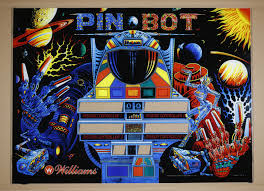It has been said that unlike video games in which the player feels they are controlling some remote character, in a really good pinball machine, the player becomes one with the game.
The pinball player melds with the machine, commanding the shot and willing the ball to do its bidding. I recently saw a seminar talk by PIN BOT sound designer, Chris Granner at Pintastic 2019 in which he emotionally broke down recalling the experience he had with the designer of Pinbot,
Python Anghelo (with Barry Oursler) in developing the machine and its connection to the player. A mind-meld, so to speak, of sight, sound, music and physical manipulation of ball to create a machine that comes to life right before the player’s eyes.
“According to Barry Oursler, Pin*Bot was unique for the fact that it was designed around the artwork instead of the other way around; Python came up with the concept and artwork, while Oursler designed the game around Python’s artwork.”
NOW I SEE YOU
Keep in mind these old games were not playing sampled wav files or sound clips. All the music and sounds were created “live” by sending code to the Frequency modulation synthesis chip. PIN BOT used a YM2151 sound IC.

PIN BOT was a great success at a time when the pinball industry needed a shot in the arm as video games in arcades were eating into the sales of these high maintenance machines and home console video games would eventually crash the market.
Williams sold 12,001 copies of PIN BOT and it spawned two sequel machines – The Machine – Bride of Pinbot and Jackbot.
Pinball machines like movies or video games, are a collaborative effort with a whole team of designers and artist pulling together their talents to produce a fun machine that will attract customers who line up to play them.
